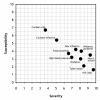Behavioural intentions in response to an influenza pandemic
- PMID: 20353568
- PMCID: PMC2861057
- DOI: 10.1186/1471-2458-10-174
Behavioural intentions in response to an influenza pandemic
Abstract
Background: Little is known regarding which behavioural responses can be expected if an influenza pandemic were to occur.
Methods: A survey comprising questions based on risk perception theories, in particular PMT, was conducted with a Dutch sample.
Results: Although fear that an influenza pandemic may occur was high, participants do not feel well informed. General practitioners and local health authorities were considered trustworthy sources of information and the information considered most urgent pertained to which protective measures should be taken. Participants reported an intention to comply with recommendations regarding protective measures. However, response and self efficacy were low. Maladaptive behaviours can be expected. Increasing numbers of ill individuals and school closures are also expected to lead to a decreased work force. Participants indicated wanting antiviral drugs even if the supply were to be insufficient.
Conclusions: Messages regarding health protective behaviours from local health authorities should anticipate the balance between overreacting and underreacting. Also, when protective recommendations from health professionals conflict with company policies, it is unclear how employees will react.
Figures





References
-
- WHO. Pandemic preparedness. Retrieved May 26th 2009. http://www.who.int/csr/disease/influenza/pandemic/en/index.html
-
- De Zwart O, Veldhuijzen IK, Elam G, Aro AR, Abraham T, Bishop GD, Voeten HA, Richardus JH, Brug J. Perceived threat, risk perception, and efficacy beliefs related to SARS and other (emerging) infectious diseases: results of an international survey. International Journal of Behavioural Medicine. 2009;16:30–40. doi: 10.1007/s12529-008-9008-2. - DOI - PMC - PubMed
-
- Sadique MZ, Edmunds WJ, Smith RD, Meerding WJ, de Zwart O, Brug J, Beutels P. Precautionary behaviour in response to perceived threat of pandemic influenza. Emerging Infectious Diseases. 2007. http://www.cdc.gov/EID/content/13/9/1307.htm - PMC - PubMed
Publication types
MeSH terms
LinkOut - more resources
Full Text Sources
Medical

